I wrote this “How to Paint Your Kitchen Cabinets (like a pro)” tutorial after painting my own kitchen cabinets almost 10 years ago. I have since quit my corporate job and started a small business painting cabinets and furniture, and have painted hundreds of kitchens, so this tutorial has become somewhat of a living document, based upon loads of research, experience and practice. I try to keep it updated with new products, tips and techniques, since I am continuously learning as I continue to grow my business and hone my own skills.
If you’re interested in reading about this project in process, you can read about it here and here. You can see my kitchen reveal here and the full evolution of the kitchen in photos here.
If you’re interested in ONLINE VIDEO TRAINING, and want to take things at your own pace, with a pro at your side through the process, click here.
If you’re in the Dayton/Cincinnati area, and want a quote for painting your cabinets, contact me.
********************************************************
Do you want to know how to paint oak cabinets?
More tips and tricks for tackling oak cabinets, including how to hide the grain, and some great go-to paint colors! Check out my post on how to paint oak cabinets for all of the details! Here are some of my favorite oak cabinet transformations from my portfolio:
- A builder grade kitchen turned custom
- Painted cabinets in an oak kitchen redo
- A client kitchen redo with an island reinvented
Do you have questions about prep?
Are you concerned about prepping your cabinets? Are they unfinished or previously painted? Check out this post on 5 Cabinet Painting Problems Solved.
Are you looking for the right tools to get the job done?
The more projects I do, the more tools and products I find. Here is my latest list of great tools to get the job done more efficiently and with a great finished look. Five Favorite Tools for Painting Cabinets and Furniture.
Do you have questions about using a paint sprayer to paint your cabinets?
Check out this post from my “Painter in Your Pocket” series as your guide.
*********************************************************
*This post contains affiliate links*
I apologize in advance on the length of this post, but I wanted to make sure I covered everything in one fell swoop. That said, I’m sure I forgot something, so feel free to ask any questions you may have.
I have put together a FREE COMPREHENSIVE SUPPLY LIST for you, and you can link to it here, click on the image below, or you can shop here for everything you need.
I did a great deal of planning and research before tackling this project, and continue to develop and learn now that I’m painting cabinets for clients, so I hope you’re able to learn from my obsessive-compulsive tendencies.
First things first. These are some of the most important things to know and consider before taking on a project like this.
1. Unless you have hired help (or a household that will take on all of your responsibilities while working on this), the rest of your house will suffer during this process.
Ok, maybe I’m being a bit dramatic here, but this was my personal experience. However, I should preface this by also mentioning that I worked full-time (outside of the home), when I painted my cabinets, and spent just about every non-working moment on this project in order to get it done. So, for me, this meant that my typical laundry “pile” turned into a laundry “mountain”. The entire house was a wreck, and the hubby and kids had to fend for themselves for the 2-3 weeks that I spent focused on painting. My kids may or may not have eaten cereal out of the box for dinner several nights in a row.
2. Invest in help from the experts.
I had three big questions in researching this project:
- How do I best prep my cabinets for painting?
- What kind of primer should I use when painting my cabinets?
- What kind of paint do I use to paint my cabinets?
- How do a I choose a paint color?
I ended up finding some cabinet door samples that I liked, and had them color matched for my kitchen.
Here are the samples I used and had color matched for the island and the kitchen cabinets.
What color did you paint your cabinets?
I have gotten a lot of questions about the color that I used on my cabinets. As I mention above, I had the cabinet samples above color matched for my kitchen paint colors. Below is the formula for the white I used on a bulk of my cabinets. This is a formula for Benjamin Moore paint, and I used their Advance paint product for my cabinets. Don’t use this formula for other paint manufacturers.
If you are looking for help choosing a white paint color for your cabinets, check out my favorite white cabinet colors here.
3. What is the best method to get the job done and make it look professional?
I know there are a lot of opinions and methods out there, but after painting the kitchen island, (using a sprayer for the doors, and hand painting the frame), I knew that painting the cabinets with a brush would not produce the look that I wanted, since I have a lot of raised panels and detail work.
However, if you don’t have a lot of raised panels on your end cabinets, I say paint your frames with a brush/roller. I still recommend spraying your doors and drawers, but there is some wiggle room with the frames. Just make sure you use a high quality brush like this one, and mohair rollers. Using high quality tools will give you a high quality finish and help to minimize brush strokes.
The clincher for me was seeing a video of someone painting kitchen cabinets with an HVLP sprayer. HVLP = High Volume, Low Pressure. It is a dream for a project like this since you have so much control over the spray in terms of volume and area. You can dial it down to a targeted, narrow spray for corners and small areas, or you can open it up to give you a much broader spray as well.
However, these paint guns can be expensive, since they hook up to a turbine (which I now have and use for client kitchens). But, I did some (more) research, and found one that I could hook up to our air compressor (ours is a 6 gallon 150psi, which was more than enough power) for a fraction of the cost. Enter the Wagner HVLP Conversion Gun. This is the gun that I used when I painted my own cabinets, and the results were nothing less than flawless.

If you don’t have an air compressor, you can go with a gun like this Graco TrueCoat Plus II paint sprayer. Thrifty Decor Chick used this to finish off her cabinets after my house call when I had the opportunity to walk her through the process. She loved this sprayer, and if you saw her kitchen, you’ll see that it got the job done beautifully.
So, let’s get to the details. How did I prep my cabinets? What type of paint did I use? What finish did I choose?
Paint Prep
Before we dive in too deeply on paint prep, let me first say that this is not a step where you want to take short cuts. I know a lot of paints claim that they are “no prep”, but if you’re investing the time to do this kind of DIY project, and you want a professional finish, you need to put in the work. I can’t tell you how many times I’ve cleaned cabinet doors and then sanded them, only to reveal all sorts of gunk that I never would have noticed otherwise. Since my cabinets didn’t have a glossy finish on the to begin with, I cleaned them Krud Kutter Gloss-Off, which is a great all-in-one cleaner AND deglosser and then gave them a light sanding. I have since invested in a nice orbital sander and dust extractor and use it for client jobs, but I will say that my light sanding has held up nicely in my own kitchen.
You can see the primer and paint that I used here as well. Benjamin Moore’s Fresh Start Primer and their fantastic Advance paint. Again, I’m going on the advice of the experts here (he recommended a different primer for glossy surfaces, but I can’t remember what). I cannot say enough good things about this Advance paint. Oh. my. goodness. The paint store guy/expert said, “It’s revolutionary.” He said that it’s basically an oil-based paint that acts like a latex (even though it is a latex paint). You get all of the good points of an oil-based paint, with none of the negative. It hardens like an oil, wears like an oil, but cleans up like a latex and it doesn’t smell like an oil! See? Revolutionary.
For a more detailed breakdown on prep, you can check out this post from my “Painter in Your Pocket” series that is exclusively dedicated to prep work.
I have experimented with a multitude of primers over the past few years, and while Fresh Start has held up nicely on my own cabinets, I am also a big fan of SealGrip by Porter Paints. It’s awesome for oak cabinets too, in that it keeps the oak grain from bleeding through the paint, and it’s water-based, which I love. Plus, it really holds up when cabinets need to be transported for clients. But as of lately, I have switched to using Zinsser BIN shellac-based primer. It sticks to EVERYTHING.
If you’d like to look at other paint options, I shared a comparison of two great products that I love. They’re both solid products, with pros and cons associated with each. It all depends upon your priorities and preferences.

But, before you can get moving with your actual priming/painting, you need to remove your cabinet doors and drawers. I highly recommend putting together some sort of numbering system so that you don’t lose track of what goes where. While it all seems to make sense when you’re planning, trust me that you will be glad you did this when your paint-weary brain goes to put the doors and drawers back.

TIP: I started out my labeling like this, but the best way is to take a piece of painter’s tape and number your cabinet doors and the corresponding frame so that it’s easy to match them up when you reinstall. Put the hinges in a Ziplock bag, and store them in the corresponding cabinet/drawer space. Take the time to number your doors and drawers, because things can get ugly really fast when reinstalling your doors/drawers if you don’t.
Below, my cabinet coding translates to – Right of stove, cabinet #28, right bottom (RB). Believe me, when you’re exhausted and swimming in a Sea of Cabinets that need to be put back in their proper place, you’ll be thankful for this little extra help.
This is especially important if you currently don’t have knobs on your doors, and you’re planning on adding them. Label the door so that you know whether it’s a right or left sided cabinet so you make sure to drill your holes in the correct spot. Just trust me on this.
You will also need to tape off the insides of the cabinets, the countertops, floor, even some of the ceiling. If you’re planning on painting the walls, do it after you paint the cabinets – you’ll save some time and trouble in taping off the walls in addition to everything else. This was, by far, my least favorite part of this project. Taping off the insides of cabinet frames is harder than it sounds. But, I can offer you some advice that I learned along the way.
TIP: Tape off the bottom, sides and top of the frame first (newspaper works well for this), and then tape off the back of the inside frame.
You can see what I mean here:
Versus here where I was trying to tape off right at the edge of the inside frames. Don’t ask me why it took me so long to figure this out, but it was a maddening process. (And don’t mind the water spot on the contractor paper – it’s from the water dispenser in the fridge. I swear.)
You will need to go all Dexter-like and tape off any open areas in your kitchen to avoid spray particles from floating through your house.
Priming and Painting
 |
Paint pattern size:
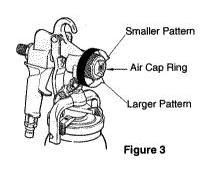 |
Air and paint flow control:
 |
Then, fill in the center area, working side to side, ensuring complete coverage.
- Clean and degloss the frame surface with Krud Kutter
-
Lightly sand the frames (I used 220 grit sandpaper)
-
Remove excess dust and wipe clean with tack cloth
-
Prime cabinet frames and allow to dry 24 hours
-
Lightly sand and use tack cloth before painting
-
Paint cabinet frames with 2-3 coats of paint, waiting 24 hours in between coats
-
Wait 2-3 days for paint to cure before rehanging doors


I hope you found this tutorial helpful, and most importantly, I hope you’ll begin to see that you can do this project!
Interested in cabinet paint colors that aren’t white? Check out this post on my Favorite Non-White Kitchen Cabinet Paint Colors.
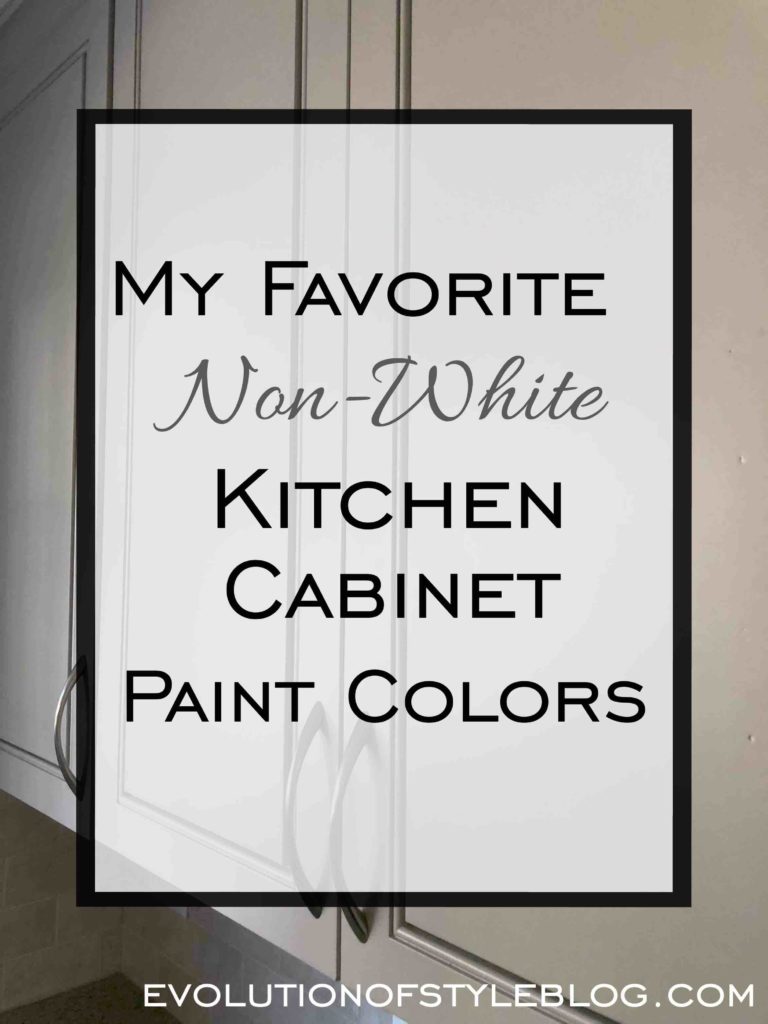
In case you missed it – here is my post with tips and tricks on painting oak cabinets.
In April 2014, I gave Behlen’s Grain Filler a test drive to get rid of the oak grain on a cabinet project.
Here is a post showing an oak kitchen transformed (by me) for a client.
Before:
After:
Here are some links to some other resources that might be useful:
Melissa at 320 Sycamore
Traci at Beneath my Heart
Sherry and John at Young House Love
Marian at Miss Mustard Seed
Traditional Painter Hand Painted Kitchens and Furniture – a treasure trove of information from seasoned pros, on materials, supplies, prep and technique, along with loads of photos of kitchen transformations. One of my favorite resources!

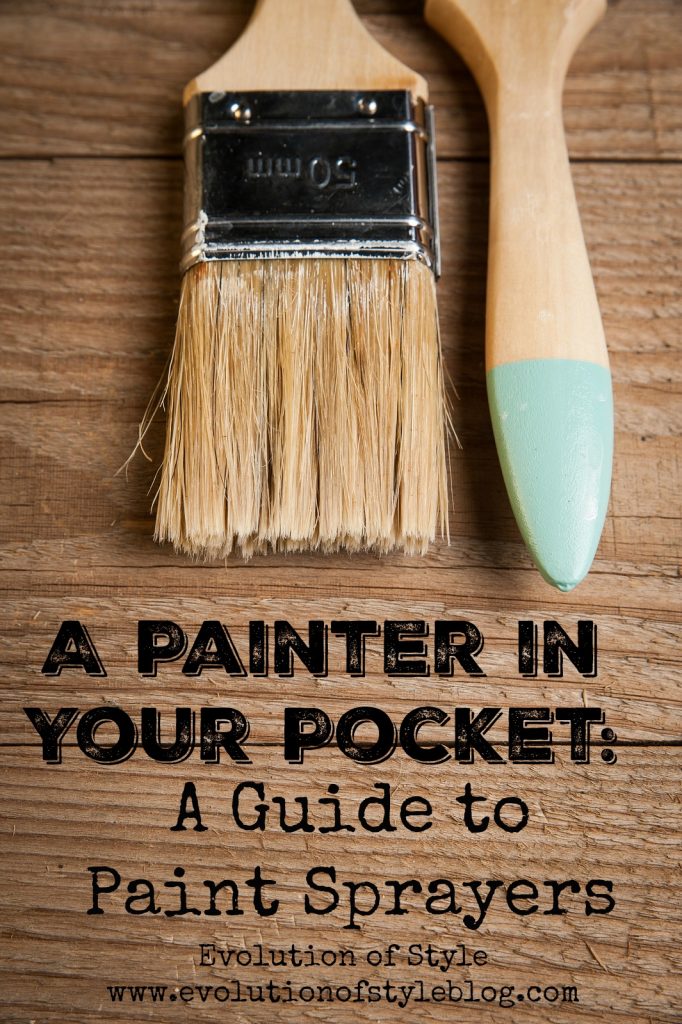
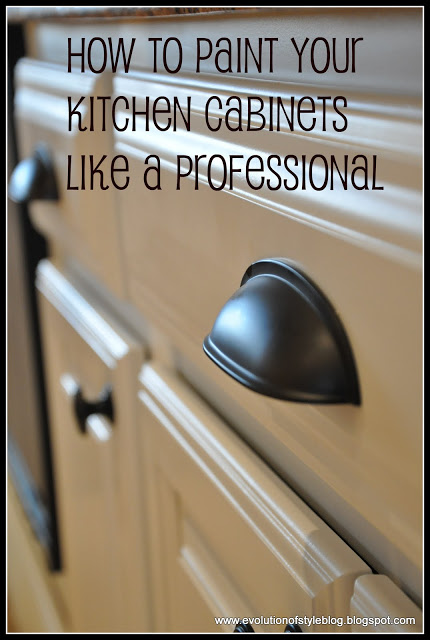
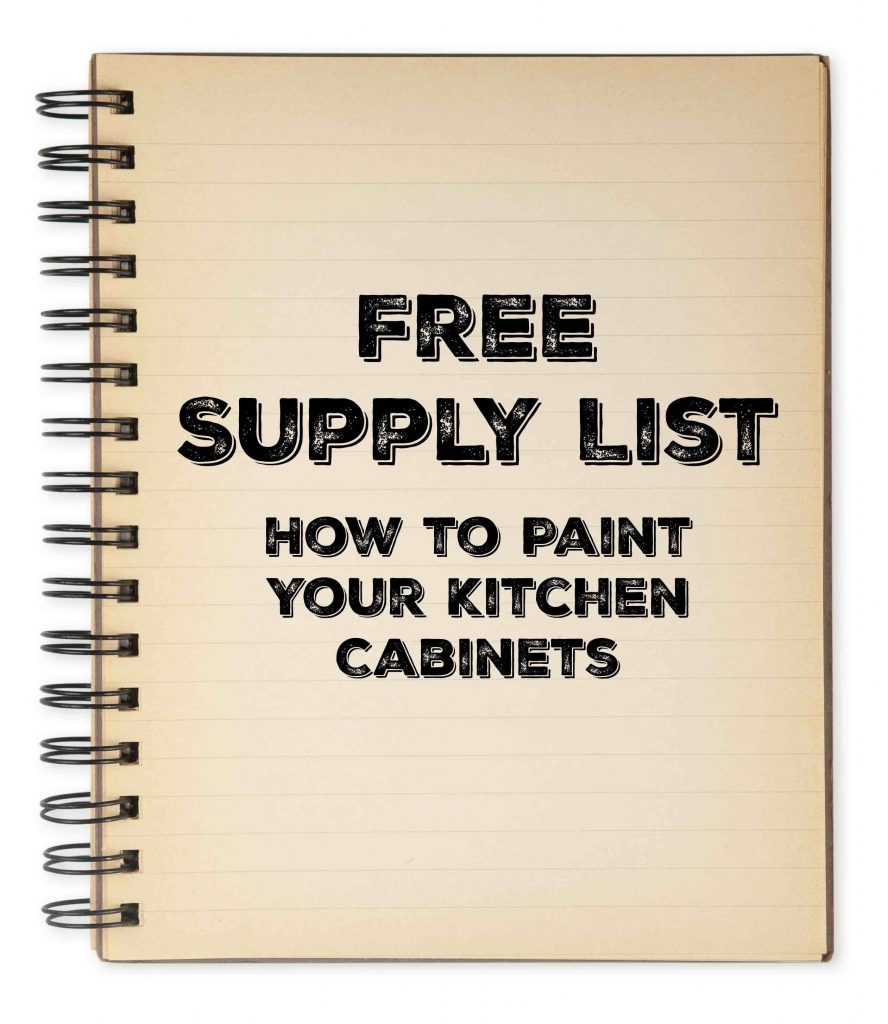
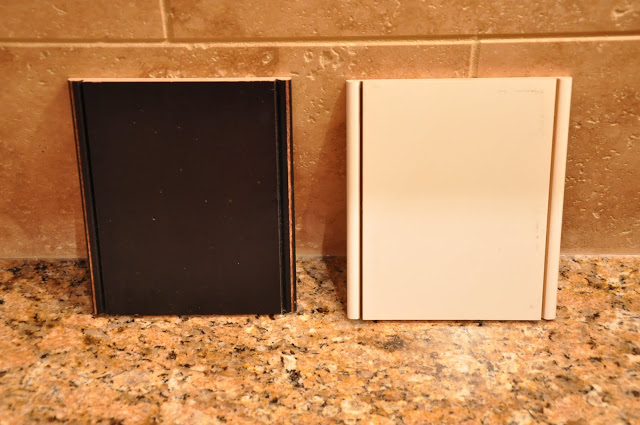
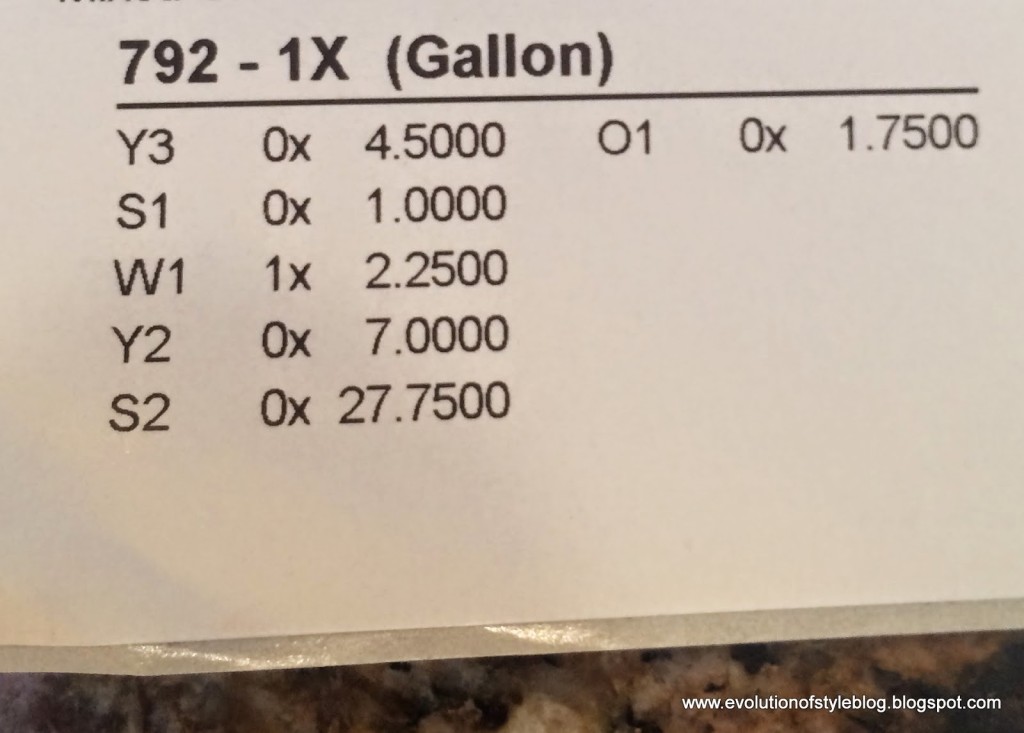

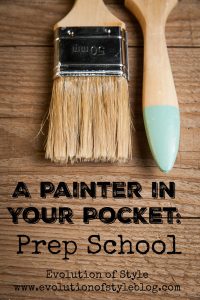
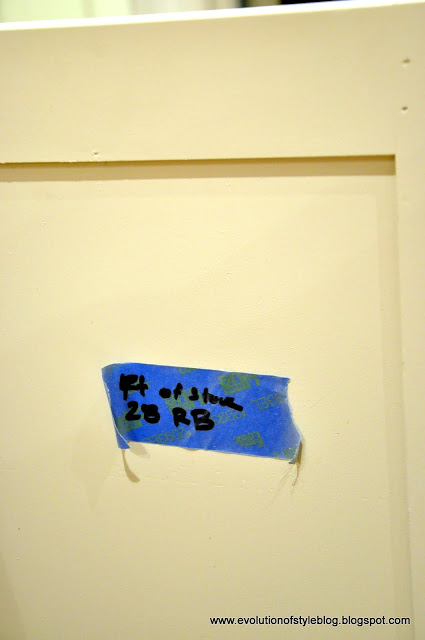
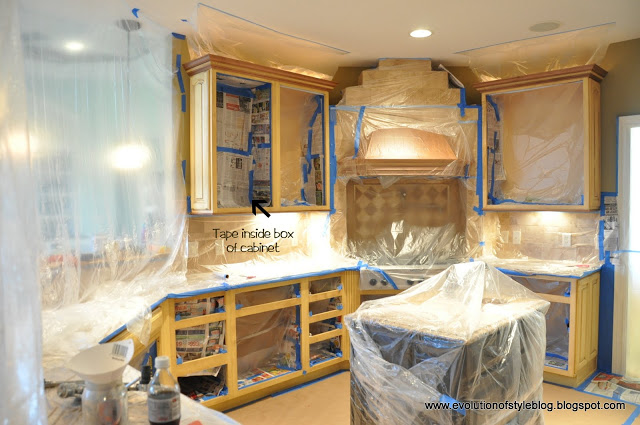





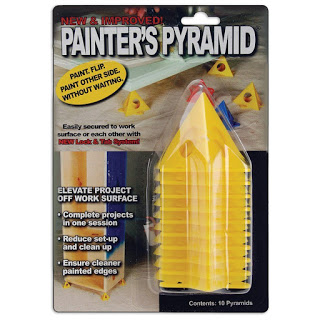



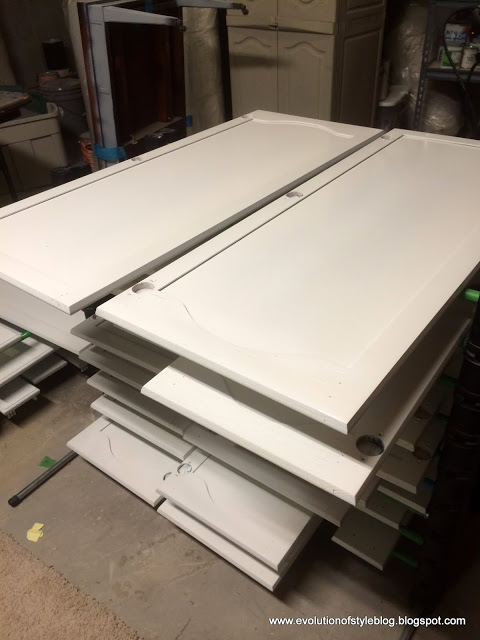

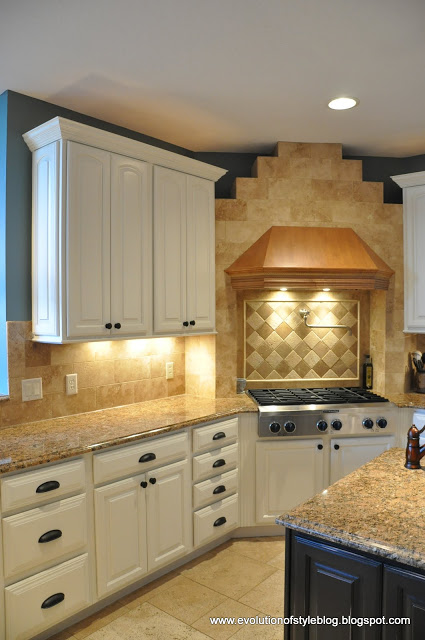

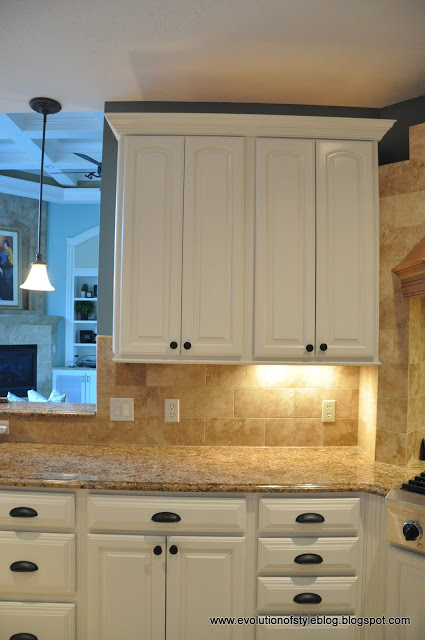
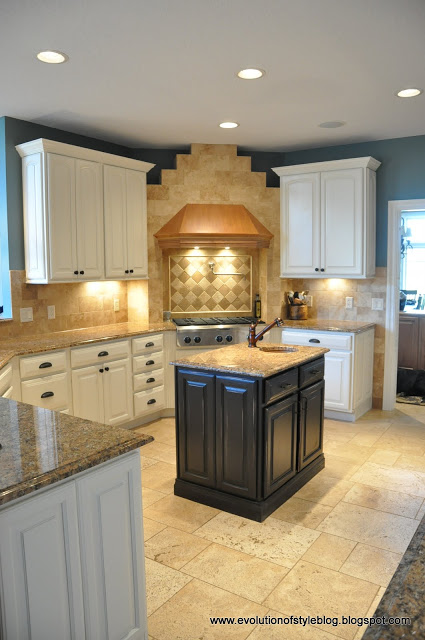
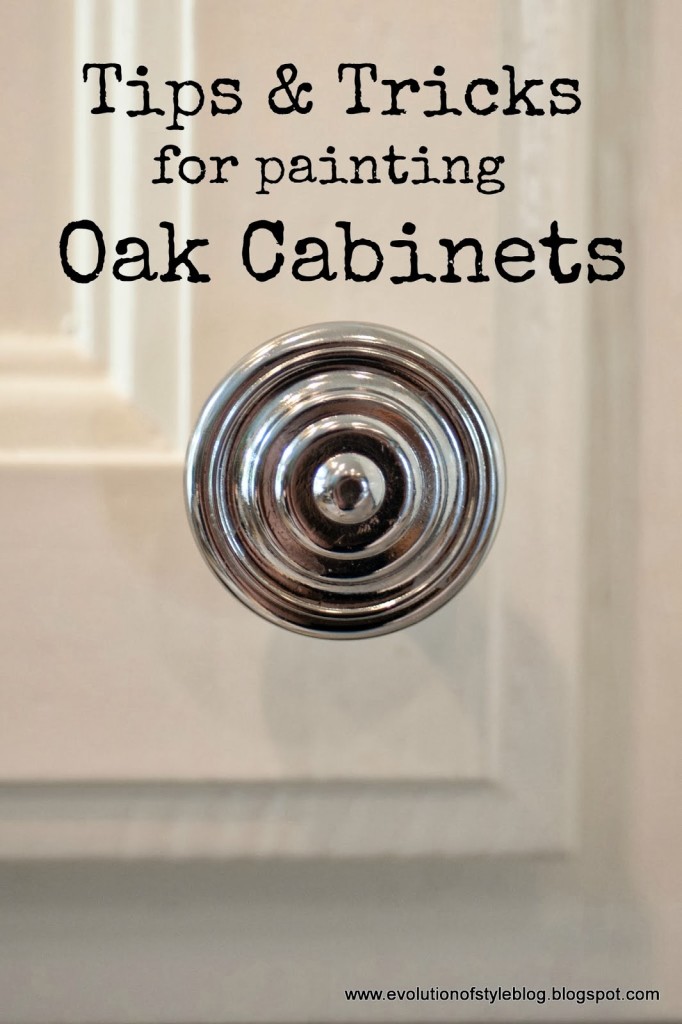

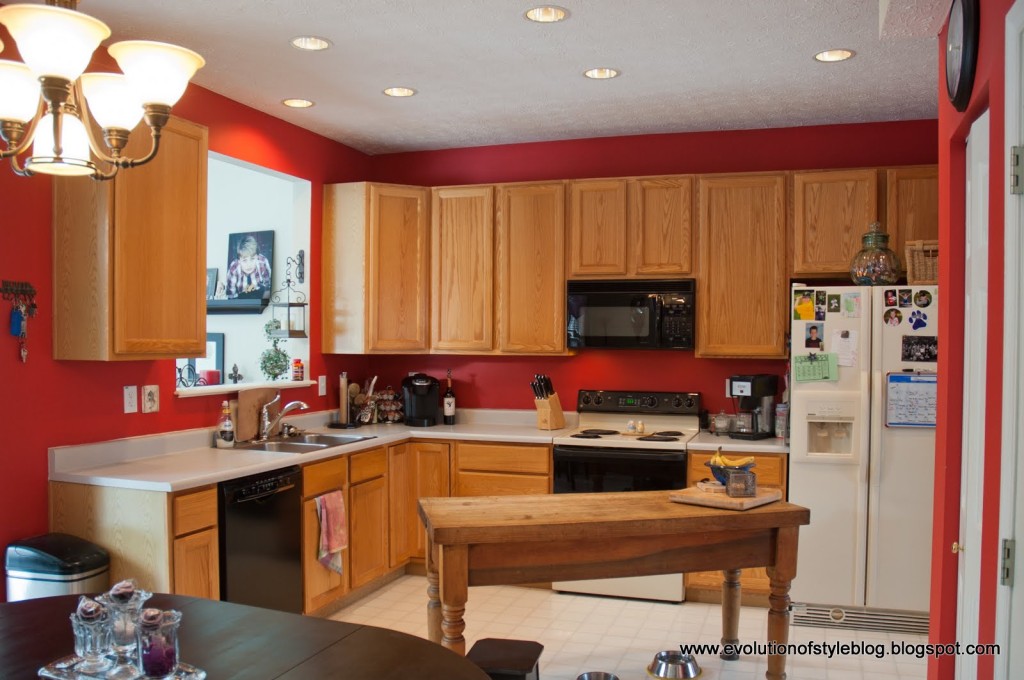
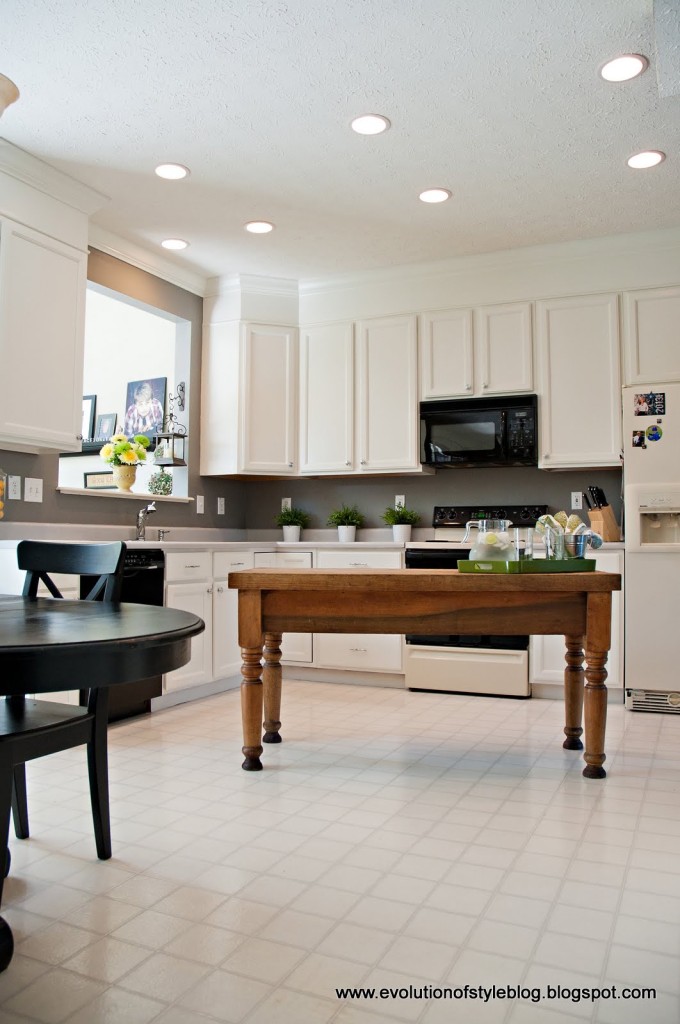

264 Comments
Jessica
June 24, 2012 at 12:14 amI found this just in time! Thank you for being so detailed and such a big help! I just finished one bathroom and I'm making my way to the kitchen. You just brightened my thoughts about tackling this job! Thank you!
Angie T.
June 26, 2012 at 4:23 amWow! Your finished product looks amazing, awesome, incredible….but I think I threw up in my mouth a little thinking of all the work. Where's that cabinet guy's number?
Anonymous
June 28, 2012 at 7:18 amJust beautiful, you've done an amazing job :).
Susan Tait
July 3, 2012 at 6:07 pmHey Jenny!
Beautiful job!!…would you recommend this same process for painting a childs poster bed?…I'm modifying a set of bunk beds into a poster bed and I'd like to paint it for my grand daughters room…
Anonymous
July 7, 2012 at 5:09 pmGreat work! Thank you so much for this article. I am currently in the middle of doing the same research and paint testing on old cabinets that I can afford to ruin. I have a couple of questions I was hoping you could answer. Did you end up sanding between each coat? Did you use a protective top-coat such as a varathane finish? I'm assuming you had to use a paint thinner in order to use the sprayer? Did you find that finding the right consistency was challenging?
Thanks!
Karrie
Jenny
July 8, 2012 at 1:49 amI did a light sanding in between coats (220 grit sandpaper), to make sure the surface was smooth. As for a top coat with a finish – there was no need for that with the Advance paint (per my paint guy). I didn't have to thin the paint either. I strained it a few times, but overall, I can't say that it really made all that much of a difference. The paint does extremely well with the spray gun. You could add a shot of Floetrol if you needed to, but I didn't need it.
Anonymous
July 8, 2012 at 6:35 pmThanks so much for replying so quickly! I really appreciate it.
Anonymous
July 9, 2012 at 3:15 amWow! They look amazing! Great job!
Anonymous
July 9, 2012 at 8:11 pmI am scared to death but I am goint o give this a try lol!!!! THANK YOU for the insight. I am a bit nervous that oak cabinets will still show the grain…any insight 🙂
Anonymous
July 12, 2012 at 12:36 amI love your kitchen!! Thank you for all your information! We are in the planning phase of redoing our kitchen cabinets and counter tops. Would you reccommend replacing the counters first or paint the cabinets first?
Jenny
July 12, 2012 at 11:13 pmI would probably CHOOSE your countertops and cabinet paint at the same time if possible, but would install the countertops after painting the cabinets. Then you wouldn't have to worry quite so much about being super precise and careful about taping off the cabinets when you paint. 🙂
amanda smith
July 13, 2012 at 10:28 pmYour kitchen looks great! I read several posts about the Rustoleum Cabinet Transformation kit. I will be using this kit on my cabinets and the salesman at Lowes had nothing but positive things to say about it. Our neighbors transformed their cabinets and they look amazing! This task seems so overwhelming but I know it will be worth it in the end..
Anonymous
July 15, 2012 at 8:47 amHi Jenny, i found your tutorial on pinterest. And wow, your kitchen looks great!
Stephanie from germany
Anonymous
July 15, 2012 at 1:43 pmI will be moving soon and will be experiencing the "joy" of painting kitchen cabinets (not!). Your before and after pictures are inspirational. I'm not very imaginative with projects and these types of tutorials are very helpful.
Thanks! P.S. Love the "Water, not pee" note! 🙂
jane
July 16, 2012 at 11:47 amBEAUTIFUL… Where were you when I painted my cabinets….makes me want to redo them AGAIN.. I thought my way was a process….what a detailed tutorial and your kitchen looks amazing.
Anonymous
July 21, 2012 at 4:47 amVery nice.
Wagner offers a lot of differnt paint guns… How did you decide on the model you purchased?
Thanks in advance,
Brian
Jenny
July 21, 2012 at 9:32 pmI did a lot of research and determined that I wanted an HVLP sprayer, but didn't want to pay the big bucks for one that runs via turbine. This one had great reviews, and it is a great tool for an amazing price.
Sonia Leclerc
July 17, 2013 at 5:23 amHi Jenny,
Could you give all the exact details about the HVLP and compressor you used?
– Brand name
– Model number
– Any other details that would help find them
Many thanks,
-Sonia
Straightcreekprimitives-Sharon N Sammons
July 21, 2012 at 2:04 pmGreat job, you done a wonderful job. I want to thank you for the information on how too. I have been wanting to do this myself just didn't know where to start.
Marge
July 24, 2012 at 2:30 pmThis is so inspiring and I love the look of your cabinets. I AM going to redo mine and this will be a God save for me. Thank you for this wonderful information!!!
Mark
July 25, 2012 at 7:38 pmThank you so much for sharing this! I only hope that mine comes out half as good as yours. By the way, thanks for the mention of Gleem Paints. I've been asking them for much advice and they couldn't be nicer.
Anonymous
July 31, 2012 at 6:31 pmJenny, thank you for sharing! I have been researching for awhile to find the best way to paint my oak cabinets and your way seems to be the best. My one question is do I need to put wood putty over the grain to keep it from showing, or do you think the primer and paint will take care of hiding the grain? Thanks!
Jenny
August 1, 2012 at 3:49 pmMy cabinets were maple, so I didn't have to deal with any issues with the grain. I have read about different ways to work with the grain (putty, filler, etc…), but am hesitant to make a recommendation without personal experience with it.
Here is a link to the kitchen cabinet paint job that Kristin did on her blog – she had oak cabinets, and it turned out beautifully.
http://myuncommonsliceofsuburbia.com/how-to-paint-oak-cabinets/
Mark Greenhaw
July 31, 2012 at 8:51 pmI am in the middle of my kitchen cabinet project. I was delayed due to some unexpected ceiling repair (sheetrock replacement, mudding, texture and paint ARGH!). I have one quick question regarding the HVLP sprayer and the Advance paint. I was told that normally you wouldn't use a latex paint in a HVLP sprayer. Is it ok because of it being the latex enamel? I see that the Fresh Start primer is 100% acrylic.
I'm new to the whole paint gun experience but look forward to giving it a go.
http://mgreenhaw.blogspot.com/
Jenny
August 1, 2012 at 3:42 pmI didn't have any issues with the Advance paint and the HVLP sprayer, and the instructions didn't put any restrictions on paint either. It goes on like butter, and I really can't say enough positive things about the Advance paint.
Hope this helps!
Maeve
August 2, 2012 at 2:56 amI watched and read your tutorial two times – you were so thorough, Jenny! I know this is going to be a big project, but I now have a clearer understanding of this project of painting our cabinets. Your idea's and wonderful advice were priceless. Thank you for giving me the idea's and gutts to take this on.
Anonymous
August 7, 2012 at 7:25 pmI know this would be different depending on the paint, etc., but what pressure did you set on the gun and the air compressor?
(I bought the gun you had great luck with… It is not working well for me as I get a lot of paint spitting. I even tried thinning it out.. No biggie though, as I just back rolled with a small foam roller with good results.)
Thanks – Brian
Anonymous
August 9, 2012 at 2:08 amThese look awesome!! You've inspired me to do the same in my kitchen!!!
Thank you!
Lisa
martachka
August 9, 2012 at 10:07 amMmmm… I never thought of painting the cabinets to renew my kitchen! This is definitely cheaper than replacing them all! I'm gonna try this some time soon. And I may use that for the bathroom as well 😉
Thanks for the inspiration!
Anonymous
August 9, 2012 at 2:13 pmwhat a wonderful post!! Your the bomb! If I ever want to try this your my guide. Thanks for the great detailed info.
Anonymous
August 12, 2012 at 11:54 pmYour kitchen is beautiful! What type of coutertops do you have? I love them!
Jenny
August 13, 2012 at 1:50 amThank you for the kind comment. As for the countertops – they're granite, but I'm not sure what the color is on them since they are original to the house.
Anonymous
August 17, 2012 at 10:37 pmI love your hardware…where did you find it. I have been looking for some like yours.
Camille
August 22, 2012 at 7:33 pmI went quickly through your tutorial and posts, so please excuse me if I'm repeating an already asked question. This tutorial is amazing. I have maple cabinets throughout my house (except for my kitchen which I had totally replaced with cherry), so I was so excited to see that yours were maple too with such wonderful results. Was this the first time you had used a sprayer? Your results were so professional. I'm just wondering what the learning curve is for a paint sprayer.
Jenny
August 23, 2012 at 5:34 pmThis is the first time I used the sprayer, and it's not a difficult learning curve. I would suggest practicing on some cardboard, experimenting with the different settings until you feel comfortable. But, it's really very easy once you get going. 🙂
Amy
August 22, 2012 at 11:20 pmWow, you really covered it all! Thank you so much for this!!
Camille
August 23, 2012 at 9:37 pmThank you for answering my first question so quickly. I've been doing some research myself and am trying to figure out how to paint the faces of my cabinet boxes which are I believe melamine with edge banding. My cabinets are frameless which if I understand that term, means that only a hint of my boxes show when the cabinets are closed. I want to go from a light natural finish to a black similar to your island. Did you ever in your research hear how to paint the edge banding which is not a natural wood surface? I haven't found anything yet. Just thought I would ask.
Anonymous
September 4, 2012 at 7:24 amPaintzoom… You posted a question, and then answered it yourself just minutes later… I am pretty sure my 8 year old could have figured that out. I would say this is all we need to know about Paintzoom. The Wagner HVLP Control Spray Max gets good reviews at amazon. I personally prefer an airless sprayer with cabinets because I think you get a smoother finish, but they are harder to work and create more overspray. With the self leveling of the Advance, the HVLP would probably be fine.
browneyed girl
September 9, 2012 at 6:17 amBought the paint sprayer, sanded the cabinets, ready to paint and my compressor breaks! Looking for a new/used one now. Can you tell me how many CFM @ 40 psi and at 90 psi your compressor sprayed? If you don't know and can just tell me the brand and model number I can look it up. I'm finding that there is a huge difference and that tank size (yours is 6 gallons) and max psi (you stated yours is 150 psi) really aren't the measure, but H.P. and CFM instead. I just want to make sure I get enough power without going overboard. Thanks for your response!
Kelly Columbus
September 9, 2012 at 4:14 pmHi Jenny! Great job! I have spent the last week researching how to professionally paint cabinets, and without a doubt yours are the best I've seen! I have high quality solid oak, custom built by the previous owners. But I am so tired of oak! My kitchen is huge, but seeing your work, I have hope! My question, I like the off white cabinets with a walnut glaze. Do you know how your process would change to include a glaze? Thank you!
Julie
September 13, 2012 at 11:42 pmI love your kitchen and really appreciate the step by step instructions for painting the cabinets. Your tutorial gave me the courage to spray my own cabinets in the garage. I have primed them and painted one coat on the back of the cabinets and was just wondering how long you have to let them dry before you can turn them over to paint the other sides. This is such a tim-consuming project, but I keep reminding myself how good it will look. I just look at your pictures whenever I'm feeling frazzled! Thanks again.
Jenny
September 14, 2012 at 12:19 amThanks Julie! What are you resting your cabinets on while they dry? If you have them elevated on nails or something like I showed in my tutorial, you can flip them after a 24 hour drying time. Can you give me additional details if your painting set up is different?
Cassie
September 14, 2012 at 3:20 amYour kitchen is amazing! We are tackling our cabinets right now. We have primed and applied 1 coat of the Advance paint, and I feel like the sheen is really dull. Were yours like that before you put more coats of paint on? Or does it get better as it cures and dries?
Andy Crichton
September 14, 2012 at 11:26 pmThats a lot of detail there, good one.
You can stack the doors against each other upright like a concertina, saves lot of space and being upright dust cant really settle on the paintwork.
Thin screw driver through the hole where the handle goes, another trick for moving doors without having to touch them.
Wish we had BM paints here, would like to try them, although need to be careful with white hybrid oil paints, as they are still prone to yellow.
As you say, labeling pretty important.
Have fun.
Anonymous
September 15, 2012 at 3:05 amLooks great with a lot of good information. Much more of a job than I want to tackle!
Lisa DiGioia
September 16, 2012 at 1:02 amWhat color BM paint did you use?
Kitchen Cabinets
September 19, 2012 at 11:01 pmThose white kitchen cabinets look absolutely GREAT. It looks like a completely different kitchen. Amazing…
Anonymous
October 6, 2012 at 11:51 amHello, they are absolutely beautiful. You did a great job!
Pat Silva
October 22, 2012 at 12:23 amI love your cabinets, you did a outstanding job, I am very handy and I am going to tackle my kitchen cabinets, I have ordered the HVLP sprayer and I have picked out my colors and I am ready, except for my compressor. I know you said you had a 6-gal 150 psi but could you please tell me what is the Horse Power. The gentlemen from gleempaint said it has to be 2HP but I can not find a pancake with 2hp. I found the Porter 6 gal, 150 psi. Is that what you have? Thank you in advance for your reply.
phoenix painter
November 12, 2012 at 1:20 pmI love the way they look. Im now thinking if i will choose that style.